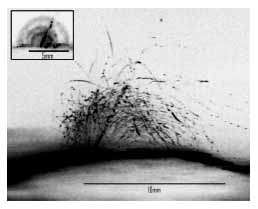April 18, 2006 feature
Scientists pin down causes of dust eruptions

By simple light and heat mechanisms, dust particles seem to defy gravity and leap up into the air. The effect, which once played a role in the formation of the Earth and asteroids, could also have applications in dust removal and even propel small probes on Mars.
When shining a red laser beam on a pile of dust, some dust particles will jump up, apparently erupting in a fountain of dust strands (see image). In studying the mechanisms behind the erupting dust, scientists Gerhard Wurm and Oliver Krauss from the University of Munster found two causes working together that explain their observations: photophoresis and the solid state greenhouse effect.
Photophoresis – or the movement of particles due to light – is based on a long-known effect called thermophoresis – or the movement of particles due to heat transfer. Essentially, in environments with temperature gradients, particles will migrate from hotter to cooler regions due to the thermophoretic force. When light absorption serves as the heat source, the mechanism is called the photophoretic force.
In addition to the presence of a temperature-gradient surface, Wurm and Krauss found that the solid state greenhouse effect also plays a role in dust eruptions. This greenhouse effect occurs because the laser beam heats up dust particles slightly below the surface (at least 100 micrometers, which encompasses several tens of particle layers) the most. In a recent Physical Review Letters, the scientists describe how coupling photophoresis with this greenhouse effect means that surface dust particles will strive to migrate away from hot underlying particles – and that direction is up.
The team found that the pull-off force for a spherical micron-size particle is around 10-7 N. On average, about a million particles are needed to overcome cohesion.
“We observed particles jump up to 5 cm,” Wurm told PhysOrg.com. “You should get them to 10 cm but this might not be the limit. The limit probably depends strongly on the dust powder, its size distribution, cohesion and the light source.”
With 50 mW laser power, radiation can penetrate a dust bed to a depth up to a few millimeters. While the temperature generally decreases deeper into the dust bed, the temperature actually peaks not at the surface, but around a depth of 100 micrometers. This reversed temperature gradient near the surface causes aggregates of dust grains to be ejected.
When the physicists turned the laser off, they observed an intriguing effect. The point where the temperature gradient changes (the highest temperature) moves deeper into the dust bed. In the tenths of seconds after the laser is turned off, the photophoretic force increases further below the surface, causing larger aggregates to be ejected from the upper part of the bed.
“When you turn off the laser, the normal cooling begins,” explained Wurm. “And since the temperature gradient at the surface is largest in absolute terms, heat flows in this direction better, which is why the maximum has to shift further into the sample.”
Because photophoresis works best in low-pressure environments (10 mbar used in this experiment), it would be rare to observe the force naturally acting on dust particles near the surface of the Earth. However, in the early days of Earth – as well as other planets and stars – photophoretic ejection at sub-mbar pressures likely played a role in the growth of gas-dust disks, which in turn triggered the formation of asteroids and Kuiper belt objects.
For future applications, the physicists theorize that Mars’ low surface pressure make the planet a candidate to host the photophoretic force. For example, with the equipment used on Mars exploration missions, photophoretic technology could aid in the removal of dust from solar panels and lenses. Further, the scientists consider creating a solar sail that would be powered by the photophoretic force instead of radiation pressure.
“You could construct a fabric which would look, for example, like a fisher-net with micron or sub-micron-sized fibers,” explained Wurm. “The individual fibers would have ‘negative photophoresis,’ which occurs when particles are pulled by the light after being ejected, and the whole net should be lifted by light. With negative photophoresis, I’d guess a sail might carry a few times its own weight just by ‘passive’ sunlight. . . Say a 10 meter by 10 meter sail might carry a few tens of kilograms.”
Wurm and Krauss also speculate on the possibility of fabricating an artificial surface that would optimize photophoretic forces on Earth, as well as industrial applications. Because all these possibilities are based on studies of “dirt,” these experiments take advantage of something often considered an everyday nuisance.
“With modern physics, it is hard to come by the effects we observed here because everyone is proud of working in a clean environment at ‘perfect’ vacuum,” said Wurm. “This is fantastic, but you never see photophoretic effects there. You need the gas, the ‘bad’ vacuum, and you need the dirty surfaces.
“With respect to planet formation, dust really holds the clues to our origins. The word ‘dust’ implies rather negative feelings because it is related to dirt in everyday life. Dust is everywhere. We will never love it and we can't leave it. You could call it micro- or even nanoscience and it might sound a little better and fancier for research – but we’re still talking about dust, whatever name tag you put on it.”
Citation: Wurm, Gerhard and Krauss, Oliver. Dust Eruptions by Photophoresis and Solid State Greenhouse Effects. Physical Review Letters 96, 134301 (2006).
By Lisa Zyga, Copyright 2006 PhysOrg.com















